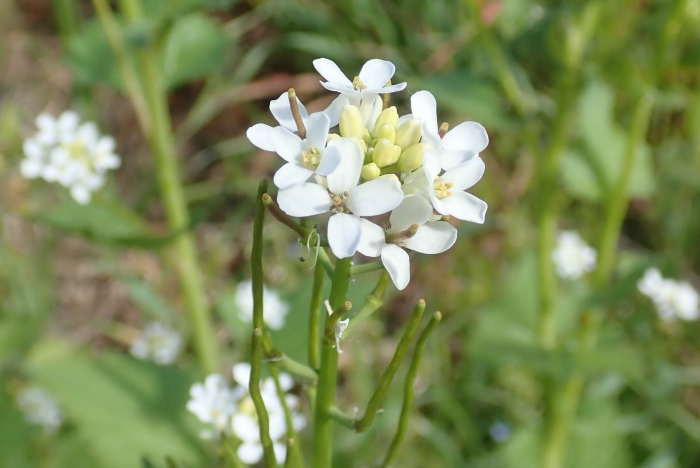Garlic Mustard
(Alliaria petiolata)
Garlic Mustard (Alliaria petiolata)
/
/

© Benoit NABHOLZ
CC BY-SA 4.0
Image By:
© Benoit NABHOLZ
Recorded By:
Copyright:
CC BY-SA 4.0
Copyright Notice:
Photo by: © Benoit NABHOLZ | License Type: CC BY-SA 4.0 | License URL: http://creativecommons.org/licenses/by-sa/4.0/ | Uploader: benoitnabholz | Publisher: iNaturalist |
























Estimated Native Range
Summary
Alliaria petiolata, commonly known as garlic mustard, is a biennial herb that is native to woodland edges, hedgerows, and shady riverbanks in Europe, Asia, and northwestern Africa. It has become invasive in North America, particularly in forest understories, where it can outcompete native flora. In its first year, garlic mustard forms a basal rosette of kidney-shaped, green leaves. In the second year, it produces cross-shaped white flowers in dense clusters atop stems that can grow up to 39 inches tall. The plant emits a strong garlic odor when any part is crushed. Flowering typically occurs from April to June, and the flowers are self-fertilizing, though they can also be pollinated by insects. The plant produces seed pods that release numerous small seeds, which can remain viable in the soil for up to five years.
Garlic mustard is known for its rapid growth and ability to spread quickly, making it a concern for conservationists. It is toxic to native herbivores and can disrupt native ecosystems by dominating the understory. In cultivation, it is generally not recommended due to its invasive nature. However, it has been used traditionally in cooking for its garlic-flavored leaves and in herbal medicine. Control measures in areas where it is invasive include hand-pulling before seed set, cutting the plants at ground level, and applying herbicides. It is crucial to dispose of the plants properly to prevent seed dispersal.CC BY-SA 4.0
Garlic mustard is known for its rapid growth and ability to spread quickly, making it a concern for conservationists. It is toxic to native herbivores and can disrupt native ecosystems by dominating the understory. In cultivation, it is generally not recommended due to its invasive nature. However, it has been used traditionally in cooking for its garlic-flavored leaves and in herbal medicine. Control measures in areas where it is invasive include hand-pulling before seed set, cutting the plants at ground level, and applying herbicides. It is crucial to dispose of the plants properly to prevent seed dispersal.CC BY-SA 4.0
Plant Description
- Plant Type: Herb
- Height: 1-3.3 feet
- Width: 1-2 feet
- Growth Rate: Rapid
- Flower Color: White
- Flowering Season: Spring, Summer
- Leaf Retention: Deciduous
Growth Requirements
- Sun: Full Sun, Part Shade, Full Shade
- Water: Medium
- Drainage: Medium, Slow
Common Uses
Edible*Disclaimer: Easyscape's listed plant edibility is for informational use. Always verify the safety and proper identification of any plant before consumption., Low Maintenance
Natural Habitat
Woodland edges, hedgerows, and shady riverbanks in Europe, Asia, and northwestern Africa
Other Names
Common Names: Hedge Garlic, Jack-by-the-hedge, Jack-In-The-Bush, Sauce-alone
Scientific Names: , Alliaria petiolata, Alliaria aculeolata, Alliaria alboi, Alliaria alliacea, Alliaria alliaria, Alliaria fuchsiae, Alliaria fuchsii, Alliaria mathioli, Alliaria officinalis
GBIF Accepted Name: